Akragas (Agrigento)
[coins] [Area II map] [Area II list]
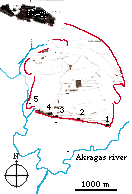
Founded in 581 BC by people from Gela, Rhodes, Crete and other islands. Since the mid of the 7C BC, however, the site was frequented by Geloan traders. The name of the city was after the river Akragas. The crab (fresh water crab of the species Telphusa fluvialitis), which is used on coins of the city, is generally believed to be a symbol of the river god Akragas. The other symbol on Akragantine coins is the (sea) eagle, the sacred animal of Zeus.
581 BC founded by Antonous and Pystilus from Gela, Rhodes, Crete, ...
571-556 BC Phalaris, first of the known tyrants of Akragas
489-472 BC Theron.
480 BC Victory over the Carthaginians at Himera (in collaboration with Gelon of Gela)
Akragantine territory, already very large, was extended to reach the north coast,
the present town of Licata in the east and the river Platini (with Eraclea Minoa
in the west.
... BC Defeat against Syracuse
415 BC Athenians on Sicily (main supporter of some of the Greek cities in western Sicily)
defeated by Syracuse
409 BC Carthaginian intervention in the border conflict between Segesta and Selinous
(to avoid that Selinous dominated a strip of land across Sicily)
Himera and Selinous wiped out by Carthage.
406 BC Akragas sacked by the Carthaginians. The city was, however, allowed to stand, but
was subject to Carthage.
... BC The city managed the regain their independence.
340 BC Timoleon sent new colonists.
286-280 BC Phintias. Territory extended again.
Gela sacked by Phintias.
276 BC Akragas taken by Pyrrhus
...-261 BC Akragas fell under Carthaginian rule.
261 BC Akragas was allowed to fortify the acropolis hill, but was forced to capitulate to
the Romans.
261-210 BC Akragas changed hands several times
210 BC Akragas permanently in Roman hands.
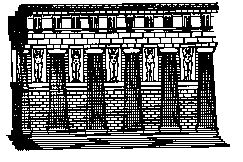
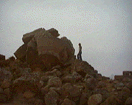
(4) 480-406 BC Temple of Olympian Zeus (or the Olympieion), 110 x 53 m.
In the fig. above one of the possible reconstructions.
Still incomplete when the Carthaginians sacked the city. Ruined by earthquakes and as a quarry for stones in the 18C AD.
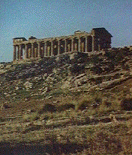
(2) 430 BC Temple F (Concordia from Latin inscription), 39 x 17 m. Converted into a Christian church in the 6C AD. Freed from these constructions in the 18C AD.
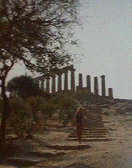
(1) 460-440 BC Temple D (erroneously attr. to Hera (Juno) Lacinia. It is the "Capo Colonna" temple of Croton that is dedicated to Hera), 38 x 17 m.
(3) 500 BC Temple of Herakles. 67 x 25 m. Eight of the nine columns were
re-erected in 1922/3.
( ) ... Temple of the Dioscuri Castor and Pollux. Built in the 19C from
old fragments. Originally a temple of about 480-460 BC (perhaps after the battle of Himera)
( ) ... Temple L
(5) 430 BC Temple of Vulcan (or Hephaestus). Never completed (columns only partially
fluted). Partly built over a small archaic temple of the early 6C BC.




